Lehava – a Kahanist
Group – Campaigns Against Arab-Jewish Marriage
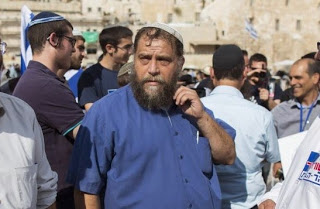 |
| Bentzi Gopshtain – leader of Lehava |
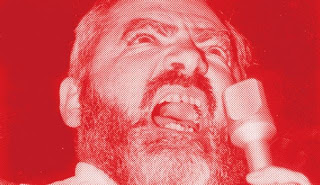 |
| Neo-Nazi Rabbi Meir Kahane – founder of Kach to which Lehava leaders belonged. Called for 5 years imprisonment for Arab males who have sex with Jewish women |
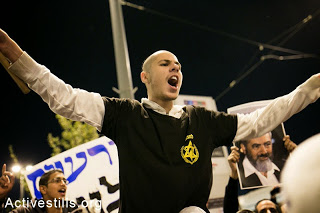 |
| Lehava fascist |
This group first
caught my attention when I read of the activities of Lehava in organisation a
demonstration outside the wedding reception of a Jewish-Arab couple, Mahmoud
Mansour and Moral Malka in Israel last year.
I wrote an article on them.
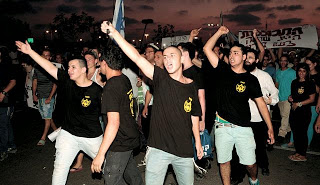 |
| Lehava – they even give the Hitler salute |
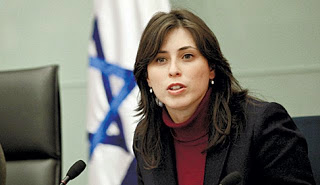 |
| Tzipi Hotovely – Likud MK who backs Lehava |
called ‘miscegenation’ inter-racial marriage is common to all virulently racist
groups. In Nazi Germany it was outlawed
by the Nuremberg Laws 1935 which forbade marriage or sexual relationships
between Jews and Germans. In Israel too
it is impossible for a Jew and an Arab to marry for the simple reason that
there is no civil marriage in Israel.
Mansour and Malka could only marry because she converted to Islam and
therefore they married according to the Islamic faith. However they couldn’t have married, as in
most civilised countries, in a registry office.
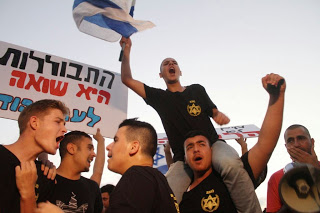 |
| Lehava fascists demonstrating outside Arab-Jewish wedding |
has always looked down on marriages between Jews and non-Jews. The origins of this are social and economic,
but once these prohibitions were adopted by a State, which based itself on the
hatred of ‘assimilation’ then this became transformed from a chauvinist to a
racist practice.
 |
| Gopshtain under arrest |
civilised world would you find demonstrations outside wedding receptions
because the marriage partners belong to different ‘races’. In Britain the National Front and BNP used to
fulminate against relationships between Black and White people but that is a
distant memory. Most people held them in
contempt. In Israel the main
anti-assimilation group, a fascist group, Lehava, is funded by the Israeli government.
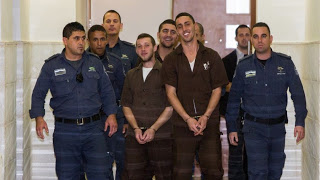 |
| 3 Lehava activists arrested for arson at a Jerusalem Arab-Hebrew bilingual school |
on intermarriage hard to swallow: In her capacity as chairwoman of the Status
of Women Committee in the Knesset in 2011, she invited the racist group Lehava
to explain how they prevent romantic contacts between Jews and Arabs.
Responding to criticism, Hotovely said it was “important to examine
procedures for preventing mixed marriages, and Lehava members are the right
people for that,” Walla reported.
 |
| Arson at the Arab-Jewish school |
A strange kind of mercy
The right-wing organization Lehava is noted for its
vehement anti-assimilation views, and many of its members are disciples of Meir
Kahane. Yet Hemla (Mercy), a group closely linked to Lehava, receives state
funding for its rehabilitation work with Jewish women. Is Hemla a good cause or
a cause for concern?
and Shai Greenberg | Ha’aretz May 27, 2011
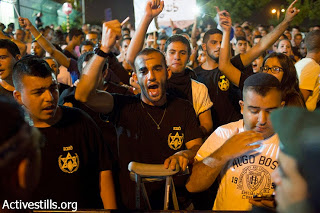 |
| Lehava fascists demonstrating |
“To my dear Jewish sister, I wanted to ask of you, my sister, not
to make my mistake, don’t let some minority member bring you down and cause you
to be impure. You’re a king’s daughter! The King of Kings! You have the
privilege of being holy and pure, you’re a Jewish woman! He wants you and the
moment he gets his way you’ll see what Hell is.” (Letter on the Lehava
website).
 |
| Demonstrating outside Jewish-Arab reception |
The posters recently placed on bulletin boards in Jerusalem’s ultra-Orthodox
neighborhoods were directed against Yesh supermarkets (the Haredi brand name of
the Supersol chain ). Under the heading “Do you want your grandson to be
called Ahmed ben Sarah?”, the poster attacked Yesh for employing Arabs,
claiming that this encourages assimilation.
 |
| Joint Bnei Akiva-Lehava parade |
The organization responsible for the posters is Lehava (a word meaning flame
and a Hebrew acronym for “Preventing Assimilation in the Holy Land”
), whose name has emerged repeatedly in recent months. The organization is
responsible for disseminating the so-called rabbis’ wives letter, which called
on Jewish girls not to date Arabs. It helped organize a demonstration in Bat
Yam in which people held signs stating “Jewish girls for the Jewish
people.” And it operates an initiative providing kosher seals of approval
for businesses that don’t employ Arabs.
 |
| Jewish-Arab couple at centre of Lehava demonstrations |
So what exactly is this organization? An investigation by Haaretz Magazine
reveals that, although Lehava is not registered as a non-profit organization or
as another type of statutory body, its leading and prominent activists are
connected to an NPO called Hemla (Mercy ), which receives funding from the
state.
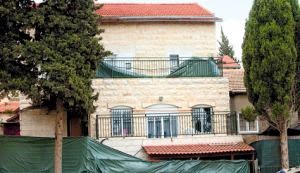 |
| Hemel-Lehava hostel for Jewish women |
Relationships with Arabs
On a quiet street in Jerusalem’s Kiryat Yovel neighborhood, behind a fence
covered with green canvas, sits the hostel operated by Hemla. In conversations
with us and from other reports, the members of the association say there are 20
women staying there. But when we arrived before Passover, the yard and the
hostel were empty. In the street we met one of the women who lives there.
“I’m a disciple of Rabbanit Baranes,” she says, referring to the
director of the hostel, Rachel Baranes. “All the girls here come from a
history of relationships with Arabs,” she adds. When we want to ask
additional questions, the girl contacts Baranes, who instructs her not to talk
to us.
Hemla was registered in 1999 as an NPO that operates for the purpose of
“distributing food items to needy families, funds for the needy for
Passover, help for bridegrooms, a fund for orphans, hospitality, loans for
those who need them, a charity that distributes dishes, a charity that
distributes clothing.” In 2002 the following goals were added: “To help
girls from broken homes who are in danger of forced conversion and of becoming
involved in crime, by rehabilitating them in a residence, and providing social
and psychological treatment and integrating them into Jewish society.” And
also “assistance for the hilltop people in Judea and Samaria.” Adding
those goals improved Hemla’s financial situation, and since 2005 it has been
receiving regular funding of NIS 600,000-700,000 a year – about half its annual
budget of about NIS 1.2 million – from the government, through the Social
Affairs Ministry. According to the ministry, the money is transferred
specifically for “treatment, support and personal and social
rehabilitation” of at-risk girls who are cared for in the hostel.
The heads of the association are outright Kahanists. Hemla’s public
relations director is Bentzi Gopstein, who in publications and interviews has
also identified himself as the director of Lehava. Gopstein is a sworn disciple
of Rabbi Meir Kahane, and on YouTube he is even identified as the director of
the memorial channel dedicated to the rabbi. Gopstein receives a salary of
about NIS 40,000 a year from Hemla.
In 1990, when he was 21, Gopstein was arrested on suspicion of the murder of
an Arab couple, who were shot to death shortly after the assassination of
Kahane. Their murder has never been solved. In 1994 he was placed under
administrative detention because of his activity in Kahane’s organization,
which was declared illegal at the time. (The late Rabbi Meir Kahane was the
founder of Kach, a political movement of the extreme right which was banned by
the government in 1988 for its racist practices, and outlawed outright in 1994
following the Cave of the Patriarchs massacre, perpetrated by a kahanist.
Hemla’s public relations director abroad is another Kach member, Levy Hazan,
who was imprisoned for his part in the shooting of a bus north of Ramallah in
which six Palestinians were wounded, in 1984. A member of the Hemla monitoring
committee, Yaron Adler, was arrested during the disengagement from Gaza along
with his wife after the couple violated an administrative order forbidding them
from leaving Kiryat Arba.
The president of Hemla is Rabbi Yehuda Kroizer, the rabbi of Mitzpe Yeriho,
who also heads the Haraayon Hayehudi (The Jewish Idea ) Yeshiva in Jerusalem,
which was established in 1987 by Rabbi Kahane. Elyakim Naiman, the chairman and
treasurer of Hemla, and Matilda Harutz, the secretary, are connected to the
yeshiva. Even the mailbox to which Hemla donors are directed is the same as the
one for donors to the yeshiva.
Hostel director Rachel Baranes receives an annual salary from the NPO that
has ranged from NIS 100,000 to NIS 160,000 in recent years. She is also in
close contact with Lehava: She signed the rabbis’ wives letter initiated by the
organization, and on one of its posters it says that she “devotes her life
to rescuing Jewish girls from the claws of the Ishmaelites.” In an
interview last October with the religious TV channel Hidabrut, she said
“Hemla was established for the purpose of building a warm home in order to
help girls – saving Jewish girls from assimilation, whether it’s foreign
workers, Arabs, [or] people with no connection to our religion.” In the
interview she spoke of rescuing a girl who was allegedly kidnapped to a remote
location in the south and “experienced physical abuse, was given drugs,
beaten, very heavy abuse.”
Baranes said that “all the rabbis in Israel” are familiar with the
association and put girls in contact with her. In the same program there was
also an interview with Shas spiritual leader Rabbi Ovadia Yosef, who praised
Baranes’ work.
There’s a plague here
A girl recently contacted Baranes in order to report a friend who was dating
an Arab, and was sent to Hemla activist Aryeh Lerr. Their conversation offers a
glimpse into the NPO’s methods. “I need as many details as possible in
advance in order to know how to operate,” Lerr tells the girl. “I
can’t tell you everything over the phone but I have excellent ways of helping.
You can go to her, talk about the subject as though you don’t know it’s
her.”
The girl then asks about the ethics of going behind her friend’s back.
“Excuse me, but if you care you do everything possible to save her,”
Lerr responds. “If it were possible to rescue Gilad Shalit would you say
‘It’s behind his back, so let’s not help him?’ It’s a matter of saving lives.
There are no games here. You’re allowed to travel on Shabbat in order to rescue
her, you’re allowed to turn on a phone on Shabbat in order to rescue her. You
can try to convince her, but it won’t help – the moment she’s touched a goy
she’s tied to him like a dog. So if you go to tell her, will that help? It may
help by a millimeter. I doubt whether she’ll leave him after your conversation
with her. If she hears me talk I believe it will shock her. It’s an initial
activity.” Lerr is then asked how many girls Hemla has rescued.
“Girls doing National Service… unfortunately, there’s a plague in
Israel.” Lerr didn’t explain what he would say to the girl that would
shock her so greatly. When asked about the difference between Hemla and Lehava
on the one hand and similar NPOs such as Yad L’Achim, he replied: “We’re
not Yad L’Achim, we’re Hemla. I suggest that you stay with us and don’t go to
another organization. Don’t confuse things now – Lehava works with Hemla. Hemla
and Lehava are together. You’ve come to the best possible place.”
Additional evidence of the connection between Lehava and Hemla comes from a
phone call to the Lehava hotline where, for example, you can report Jews who
rent apartments to Arabs or Jewish women who go out with minority group
members. Speaking to a potential Lehava donor, a spokeswoman said: “The
basis here is entirely voluntary, not financial. When I have a specific girl I
transfer her to Hemla, which is the rehabilitation place, and that’s it. There
they really need money – it’s a place where they bring girls who have dated
Arabs – and the money really goes for good and positive purposes.”
A real problem
Last February, a month after the publication of the rabbis’ wives letter,
the Knesset Committee on the Status of Women convened for a discussion on
assimilation. Committee chairwoman MK Tzipi Hotovely (Likud ) presented the
statistics from the Knesset Research Committee: “We’re talking about 92,000
families in Israel in which one of the partners is not Jewish – we have a real
problem that we have to deal with.”
Alina Tzanani, the representative of Yad L’Achim, noted the dangers inherent
in changing women’s identities from Jewish to Muslim. “They are unaware of
the later consequences for the children, who up to the age of 18 are considered
Muslim,” she said, adding her organization received many requests from
such women. “We’re seeing a constant upward trend. In 2008 there were 500
cases, now we already have over 1,000 cases a year, which is something like an
average of seven requests per day.” Justice Ministry attorney Yossi
Hershler, who is in charge of religious changes that are not conversions, noted
that the country has no precise numbers regarding the number of Jews who
converted to another religion in the past year – “but of course I didn’t
have a thousand coming to me, there were fewer,” he said at the end of the
proceedings. “I can say that it involves all socioeconomic groups in the
State of Israel.” Shahar Ilan, vice-president of Hiddush – For Religious
Freedom and Equality and a commentator on ultra-Orthodox issues, says the
subject of relationships between Jewish women and Arabs receives extensive
coverage in the Haredi press and is regarded as a serious problem by the
community. “Because life in Arab villages often becomes unpleasant for the
Jewish partner, rescuing Jewish women from Arab villages has become popular for
the associations fighting assimilation. It’s the easiest way to attract publicity,”
Ilan says. “For the Haredi newspapers, Yad L’Achim’s rescue stories are
the equivalent of heroism stories about elite commando units. However, the
rescues only involve dozens of families, while they create the impression that
there are hundreds of cases. I don’t know if there’s any way to check the
extent of the phenomenon.” Gad Barzilai, a professor of law, political
science and international studies at the University of Washington, says there
is no legal problem with government support for organizations like Hemla.
“The main point is ethical, that the State of Israel supports groups that
cause an unacceptable separation of the Arab minority. If someone tries to
petition the High Court of Justice against financial support of a body that actually
wants to prevent the possibility of social connections between Jews and Arabs,
I’m not certain that the petition won’t be granted and the support won’t be
rejected,” he says. “As long as this behavior is limited to a small
number of voluntary, non-government organizations, it’s not important. But if
it should spread like wildfire, then the State of Israel will have to decide if
organizations involved in systematically discriminating between Jews and Arabs
don’t receive the support of the Israeli taxpayer. What is on the public agenda
here is the question: What are the limits to promoting Jewish ideology in the
context of a democratic regime?”
An ethnic republic
Barzilai warns that international developments are liable to exacerbate the
battle over the identity of the state as Jewish and democratic, “which may
be Israeli society’s main battle. The world is likely to recognize a
Palestinian state, and that will strengthen xenophobia against the Palestinian
minority in Israel. Very strong chauvinistic tendencies are liable to lead to
Israel’s international isolation, which is why the story of Lehava is important
rather than esoteric. Lehava heralds the desire to turn Israel into an ethnic
republic that encourages a type of regime that is already unconstitutional in
the Western world, to encourage Jews to distance themselves socially from
Arabs. It’s very problematic.”
The use of an “informer” network for reporting on the rental of
apartments to Arabs, and Lehava posters claiming that “Arabs are harassing
Jewish girls and violating their honor for nationalistic reasons,” led
Gush Shalom to submit complaints to the attorney general against Lehava for
incitement to racism and murder. There has not yet been a decision to launch an
investigation, and the Justice Ministry said that “recently complaints of
a similar nature have been transmitted to the Justice Ministry after the
publication in the media of the ‘Rabbis’ wives letter.’ The State Prosecutor’s
Office is investigating all the complaints, and after they decide on a basic
policy, suitable decisions can be made in individual cases as well.”
Moshe Negbi, Israel Radio’s legal commentator, says it’s clear that
“activity of this type ostensibly constitutes a crime of incitement to
racism. To advocate non-employment of Arabs is classic incitement to racism.
It’s a crime that carries a five-year prison term, and it’s also incitement to
violate the Equal Employment Opportunities Law. The problem is that there is
terrible weakness in enforcement against incitement to racism. For months there
has been no action taken against Rabbi Shmuel Eliyahu and others who called on
people to refuse to rent apartments to Arabs in Safed. The real danger is when
it’s done by people who are influential, whether because of their personality
and their spiritual authority as rabbis, or because they speak in the name of
religion, which for the believer is absolute truth. That’s why this incitement
is much more dangerous. I think that one of the universal lessons of what
happened in Europe in the 1930s is that it’s dangerous to remain silent
regarding racist incitement, ostensibly in the name of freedom of
expression.”
And Hemla presents itself as helping girls in distress.
“The fact that a particular group presents itself in a certain way
doesn’t grant it immunity. The question is whether there’s evidence of
incitement. There’s no question that opposition to assimilation is a legitimate
religious and even Zionist viewpoint, in the context of freedom of expression.
But if you carry it out by means of incitement to racism, by violent means or
threats, then it crosses the criminal line. I think, for example, that the
rabbis’ wives letter is legitimate, because you can tell people that their
religion forbids them from marrying, and that the interest in preserving the
Jewish people requires lobbying in favor of marriage to Jews. But if it goes
over to threats against those girls – ‘If you do that then we’ll condemn you,
we’ll exclude and ostracize you’ – then it becomes non-legitimate.”
The village girls
A woman named Sarit from Be’er Sheva, who is being helped by Yad L’Achim,
participated in the same discussion in the Knesset Committee on the Status of
Women. Sarit said she had a relationship with a Muslim man, during which she
distanced herself from her Jewish identity and went to live with him in an Arab
village. “There my suffering increased,” she recalled. “I became
involved in a tremendous identity conflict. The children and I were, in effect,
the dirty Jews.” After Sarit spoke, MK Hotovely asked Gopstein – who
participated in the discussion as a representative of Lehava – how the
government could help women in her situation. Gopstein said he had discussed
the issue with Rabbi Kahane, “and we came to the conclusion that we have to
get to those girls beforehand. We have to get to these girls before they arrive
at the Arab village and then it’s much easier. After they come to the Arab
village they can pick up a phone and the police get them out. But how do we get
to the girls before they arrive in the village? And that’s the objective of
Lehava. That’s why we go everywhere we can, we go to schools, we go to places
of entertainment where the girls are, and we talk to the girls and explain to
them what it means to be a Jew.” Gopstein complained during the Knesset
proceedings about a lack of cooperation between the educational institutions
and the government on the one hand, and organization activists on the other.
“We go into schools by all kinds of other means, because the Education Ministry
doesn’t allow us to enter schools,” he said. “The Jewish Agency
invests millions in the war against assimilation abroad – in Israel they don’t
invest. Not only don’t they invest, it’s seen as legitimate. I’m not talking
only about Arabs. Today every girl wants to be Bar Refaeli. Did anyone even
mention the fact that she’s going to marry a non-Jew? [She recently broke up
with Leonardo DiCaprio.] Everyone will tell me, why are you talking about that?
It’s racist… We’re not racists. Racism is the theory of race – that’s why the
Knesset has to pass the Racism Law to exclude this issue of religion. We have
to strengthen Jewish identity. To bring more talk about Judaism, more talk
against assimilation, into the schools.” In the discussion MK Michael Ben Ari
(National Union ) said he supported the activity of Lehava and Hemla. “In
the name of proper disclosure I often have joint activities with them, Lehava
and Hemla and Rabbanit Baranes, who is being modest here and has rescued over
700 girls to date. She doesn’t give up. I have brought girls to her and, from
the moment she receives them, she pampers them, gives them psychological
treatment, takes them shopping and in the end also marries them off according
to Jewish law.” Hotovely added she was favorably impressed by a visit to
Baranes’ Hemla hostel. “I saw girls there who came from very surprising
backgrounds – from the center, the north, the south, Bnei Brak, not only mixed
cities,” she told Haaretz this week. She says she is not familiar with
Lehava, even though its members participated in her Knesset discussion. The
girls, she says, had a “background of emotional family problems – not
ordinary girls – who had been subject to harsh violence, humiliations and scorn
on the part of their partners. The place really rehabilitates the girls,
there’s an entire protective system that takes care of them.”
What is your opinion of the fact that Rabbanit Baranes signed the rabbis’
wives letter?
“I didn’t know that, but it sounds logical to me. She deals with all the
damage of assimilation. For years we fought against assimilation abroad and
there’s no reason why we should be separated from it when it happens here,
inside Israel. The greatest Zionist danger was that the nation was being
decimated abroad because of assimilation, so in my opinion it’s a very
important battle on the national level.”
Should the state, via the Social Affairs Ministry, be paying for this
battle, not to mention the fact that activists in Hemla are declared Kahanists?
“Unfortunately, it’s always girls with a classic welfare background.
Some of them are rescued from life-threatening situations, so it’s legitimate
for the state to fund that. You don’t have to be a Kahanist in order to oppose
assimilation. There’s a Zionist viewpoint that says Jews should marry Jews. You
have to note that it always happens between Jewish women and Arab men, there
are almost no opposite cases. It happens because in large part these are girls
who begin relationships without knowing that the men aren’t Jews, and when they
find out, it’s already too late. Often there is generosity and giving that
suddenly turns into serious violence.”
Not good for the girls
Although in almost every interview and publication the members of Hemla and
Lehava don’t conceal their opposition to relationships with Arabs, in a
conversation with Haaretz they preferred not to refer to the subject and didn’t
sanction a meeting with the girls. In a phone conversation, Gopstein – speaking
as head of Hemla’s PR and the director of Lehava – claimed that relations
between Arab men and Jewish women are no longer the organization’s top
priority. “A few years ago it was more the issue of girls with Arabs but
today that’s less important – it’s more a concern for Haredi girls with all
kinds of problems. For Haredi girls [the Hemla hostel] is the only place there
is. They don’t get along with the family, there’s incest, things like that…
not necessarily Arabs and not assimilation. This is the place for Haredi girls
who can’t remain at home.” In a conversation with Baranes, she also said
she wasn’t involved in the assimilation issue any more: “Most of my cases
are from Haredi homes that have failed, [girls] from ordinary homes that got
into trouble.” When pressed about assimilation she says, “I used to
be more involved, today I’m involved in something else.”
Yet six months ago you were interviewed on Hidabrut about the subject…
“True, I’m very knowledgeable about the subject because of my
experience over 20 years. Here and there a girl like that falls and I help her,
but in general it’s not only that.”
Haaretz turned to the Social Affairs Ministry with a list of questions about
Hemla’s funding and ideological stance. The ministry did not reply to most of
the queries, but claimed it simply funds rehabilitation and not the NPO’s other
objectives. “The ministry funds and supervises the framework designed for
girls at risk [which is operated by Hemla] in order to guarantee them
treatment, support and personal and social rehabilitation. The ministry, by
means of the supervisors, keeps track of the therapeutic plan for each girl and
the professional content, such as individual and group therapy, enrichment,
etc.
“Since 2005 hundreds of girls have been cared for in the hostel, and
most have succeeded in bringing about a significant change in their lives and
escaping the cycle of distress. We would like to emphasize that the ministry’s
connection with the association is to implement a targeted and specific program
in this framework, to which the ministry allocates a budget. The Social Affairs
Ministry has no authority to supervise and to examine other activities of the
association that are not related to this specific framework. It is not the
Social Affairs Ministry that sends patients to the therapeutic frameworks that
it funds, but social workers, workers in various organizations, and independent
requests.”
The Social Affairs Ministry did not permit Haaretz to talk to the woman
responsible for the hostel on its behalf, and did not answer questions about
support for associations that try to prevent relationships between Jewish women
and Arab men, and the question of Baranes’ signing of the rabbis’ wives letter.
However, ministry spokeswoman Ronnie Malkai said: “We don’t examine
whether or not the girls go out with Arabs, we have no agenda that says ‘Don’t
go out with Arabs.’ We have no way of checking it, and no authority to look for
ways of checking it. The people who have to enter the picture here and examine
complaints about the association are the state comptroller or the State
Prosecutors’ Office. We can’t say that we won’t fund the association because
the director wrote a racist letter or disseminates hatred, because we’re not
the ones who decide on that – our hands are tied and I can’t intervene, it’s
the job of the attorney general. We don’t have the authority to decide that is
what the hostel and the association are doing, and before you turned to us we
were unaware of it. [Otherwise] we might have taken steps to investigate
it.”
Mixed message
He’s an Arab, she’s a Jew, and they’ve been married for 25 years. So why
are they hesitant to recommend their experience to others?
Right wing organizations are always raising the subject of violence against
the Jewish partner, but a mixed couple we spoke to describe violence of another
kind − social ostracism and incessant attempts at persuasion, involving an
invasion of privacy − because their personal romantic choice does not suit the
desired social identity.
Salah the Muslim and Sima the Jew (not their real names) have been married
for 25 years, have two children and live in a mixed city in the center of the
country. Sima recalls being uncomfortable with her experiences with Kahane’s
disciples in the 1980s: “At the age of 16 I fled from home [because of her relationship
with Salah]. The police brought me back because I was a minor and for a year,
until the age of 18, they shut me up at home. I couldn’t go out by myself, only
with a chaperone and to certain places. During this period there were two
Kahane guys who simply became part of the family. I would ignore them, I kept
away from them as much as possible.”
What is your opinion on calls against relationships between Jews and
Arabs?
“These organizations see it incorrectly. In our surroundings there are many
mixed couples, and there are many others who are opposed to it. Everyone
protects his own. I would also like to keep my daughter close to me, to protect
her from an incorrect choice, but it’s still her choice. I can try to guide her
but I can’t undermine her. There’s a limit. At a certain point you have to let
go, not make her life miserable or to punish her − as used to be the case,
where they shaved the girls’ hair off so they wouldn’t leave the house.”
Sima says her family ostracized her because of her decision to marry Salah.
“My grandfather was a rabbi,” she says. “Today I’m in slight contact with my
mother, without the knowledge of my brothers and the other men in the family.
Salah went through a lot with me. I was a lone woman, who became involved in an
unfamiliar culture, and he received all the ricochets from my family. It’s very
hard.” Salah says that all the mixed couples he knows suffer “from many
problems. I love my wife and the children but I don’t suggest to anyone to
marry a Jewish girl,” he sighs. “It’s a serious problem.”
Rescue missions
Hemla’s roots lie in an association called the Fund for Saving Souls,
providing a direct link with Baruch Goldstein, perpetrator of the Cave of the
Patriarchs massacre.
Relationships between Jews and Arabs always preoccupied Kach, which claimed
in its political platform: “There is no possibility of coexistence between Jews
and Arabs except through separation: Arabs to Arab countries and Jews to Zion!”
In 1984, the year when Rabbi Meir Kahane won a Knesset seat, the members of the
movement established a fund to handle cases of young Jewish women who went out
with Arabs, which was headed by the secretary general of Kach, Eli Adir.
In 1985 Kach established the hostel Yad La’ahayot in Kiryat Arba. According
to posters distributed by the movement, the hostel was meant to “rescue Jewish
girls with their children from Arab villages.” The hostel was run by an
association called the Fund for Saving Souls. Viewing the association’s file
reveals its goals and modus operandi as being almost identical to those of
Hemla, and in addition some of the people active in Hemla − such as Matilda
Harutz and Anat Gopstein (Bentzi Gopstein’s wife) − were also active at the
time in Yad La’ahayot. Incidentally, one of the members of the association was
Baruch Goldstein, who carried out the Cave of the Patriarchs massacre in 1994
where 29 Muslim worshippers were murdered.
In a recent interview for the Orthodox magazine Ma’ayanei Hayeshua, Gopstein
recalled her time at Yad La’ahayot: “Today when I see the children of girls
whom we took care of in that home at the time − young girls whom we rescued
from Arab villages and a life of oblivion − I say to myself: What a miracle
that we managed to rescue them in time.” Today, said Gopstein, attempts to
“rescue” girls who are in relationships with Arabs continue as part of Lehava.
“We try to explain to each girl that she is the daughter of a king and the
importance of her being a part of the Jewish people.”
Yehudit Amusi, who worked at Yad La’ahayot, told Haaretz this week that the
place “lasted for barely a year.” She says there were “only four women there,
aged between 25 and 50, with difficult stories of abuse. I was asked to give
lessons on spiritual culture on a voluntary basis, evenings of a pleasant
Jewish atmosphere, and to bring some happiness.” She remembers that “one of the
women disappeared, another fled abroad, one returned to her family home and I
don’t recall what happened to the fourth. And then it fell apart. Later I think
the hostel moved to Jerusalem.”